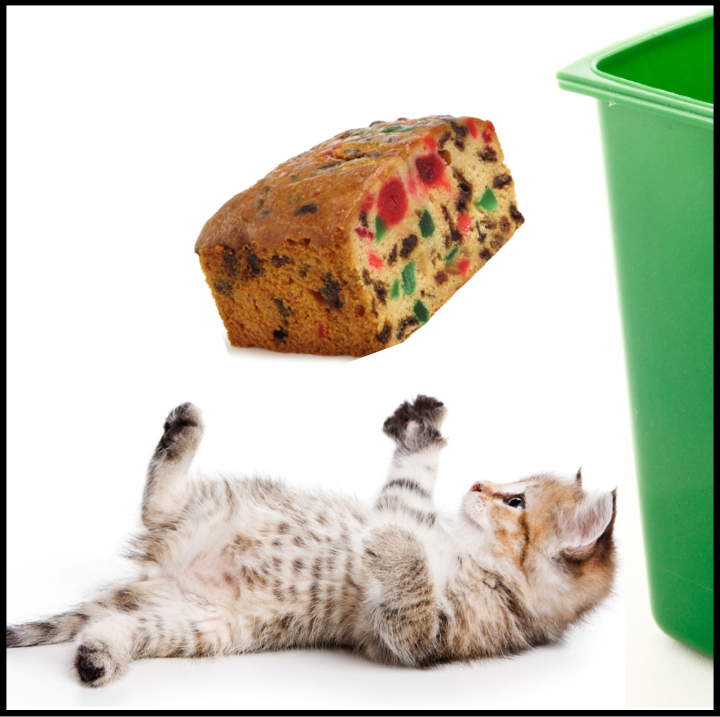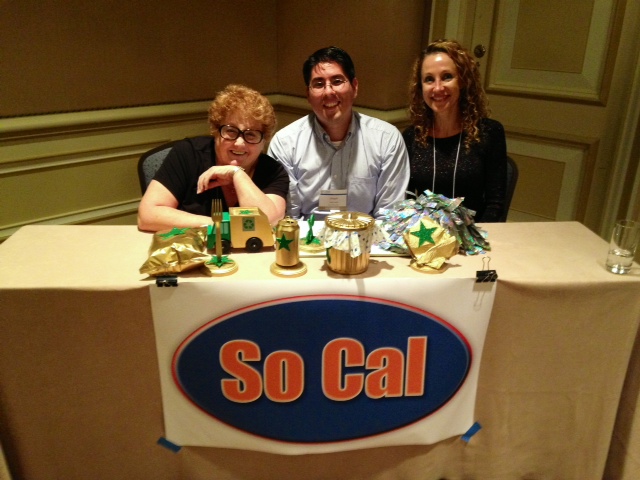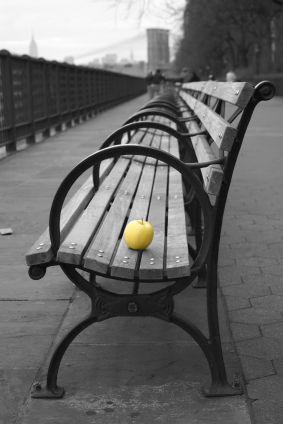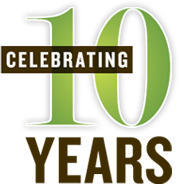
Once More, with Feeling: Incorporating Emotion in Environmental Outreach


 The Gigantic Idea Studio team attended the San Francisco Community-Based Social Marketing training in February. No, not THAT social marketing – there was no Facebook fanning or Twitter theory involved. Social marketing in this case is the process of encouraging behavior change for social good. In our case, that means fostering eco-friendly behavior such as recycling, waste reduction, preserving water quality, and so on. While our firm also employs other methods of promoting environmental programs and behaviors, CBSM remains the most studied and proven process for facilitating behavior change. While our team members have previously studied and practiced CBSM for years, we know it never hurts to take time for a refresher course in order to deepen our understanding.
The Gigantic Idea Studio team attended the San Francisco Community-Based Social Marketing training in February. No, not THAT social marketing – there was no Facebook fanning or Twitter theory involved. Social marketing in this case is the process of encouraging behavior change for social good. In our case, that means fostering eco-friendly behavior such as recycling, waste reduction, preserving water quality, and so on. While our firm also employs other methods of promoting environmental programs and behaviors, CBSM remains the most studied and proven process for facilitating behavior change. While our team members have previously studied and practiced CBSM for years, we know it never hurts to take time for a refresher course in order to deepen our understanding.
Perhaps the biggest point McKenzie-Mohr made during the training was that CBSM is a process, a full set of steps to follow to ensure you have the best chance at success. He was quick to point out that using one tactic on its own—doing a pledge or a prompt for instance—was not truly CBSM, if it wasn’t selected based on completing the steps of behavior identification, researching barriers and benefits, developing strategies and piloting.
It was an informative four days for our team at the trainings, where we worked closely in groups to practice CBSM techniques. We have always encouraged our clients to use the full CBSM process, but understand that sometimes budget and timing gets in the way. Fortunately, the training offered various options for completing the research and evaluation steps that make the CBSM process work, in ways that save money, but still allow for your strategies to be chosen based on actual information from your community.
Having completed the advanced training allows us access to McKenzie-Mohr’s CBSM presentation, and he encouraged attendees to deliver the presentation to key decision makers. Armed with the background on CBSM’s effectiveness, it is easier to convince funders, boards, managers and directors to approve outreach projects that use the full CBSM process. We would be happy to deliver this presentation to any of our clients!
Our April Fool’s quiz asked readers to say which of four possible waste reduction innovations was true:

A. Self composting organics carts in Abu Dhabi,
B. Pneumatic tube waste system in Germany,
C. Recycling drones program in San Jose, or
D. Cat hair balls in the organics stream in Portland.
The right answer is B! There is, as some of our commenters pointed out, a long history of using pneumatic tube systems to collect trash. The practice began in Sweden, and has been used since in several towns in Europe, at least one Olympic Village, and even at Disney World. Our own Stefanie Pruegel let us know that the system installed in Munich for the 1972 Olympic Games is still in use, now serving the 3,500 condos created from the Village once the games were over. She knows this because her mother lives in one of the buildings.
We were delighted by the erudite and thoughtful responses of so many of the commenters. Of the 16 “votes” received, six picked B, followed by three each for A and C, two for D (ah, those cat lovers!), and one for None of the Above. Thanks for taking up the challenge and responding with such care.
One thing the blog and your responses made clear: When it comes to waste reduction (by which we mean all of the 4RS— not just “reduce”/prevention), there are many right answers…and some have not yet been discovered. No fooling!
(In case you were wondering: the April Fool’s blog author, Avril Poisson, is not a new Gigantic staff member; it’s just a play on words from the French version of April Fool’s, Poisson d’Avril.)
At Gigantic, we always try to be creative and light-hearted, so when it came time to send a New Year’s greeting to our email list, we decided to try something a bit different: a greeting with a link to a five-second poll, asking folks to vote on which of the two images (below) they would most likely click:
 Our greeting was sent to Gigantic’s email list and posted via Facebook and Twitter. We were delighted by the response: a 46% open rate on the email, a whopping 64% click-through rate, 101 poll votes and over a dozen comments on the blog. We know via Analytics that most of the visitors on January 6 (the day we published the poll) were new to our website, and that on average, folks stayed on our site nearly one minute — not bad for a 5-second poll!
Our greeting was sent to Gigantic’s email list and posted via Facebook and Twitter. We were delighted by the response: a 46% open rate on the email, a whopping 64% click-through rate, 101 poll votes and over a dozen comments on the blog. We know via Analytics that most of the visitors on January 6 (the day we published the poll) were new to our website, and that on average, folks stayed on our site nearly one minute — not bad for a 5-second poll!
Our original intent was to draw attention to the popularity of cat memes and to suggest that pop culture knows a thing or two about spreading ideas. Well, you surprised us. The winner is … Option A! Receiving 58 percent of the votes, this more serious image showed a stale fruitcake going into a typical organics pail for composting. The adorable kitty, juggling the fruitcake before tossing it in the bin, garnered only 42 percent. This startled us on several counts (we thought the kitty was cute and was the obvious choice for attracting more eyeballs), and as we analyzed the results, we drew several lessons:
Clarity matters. Several comments argued that more specificity was needed in the kitten image, noting that it wasn’t clear that the fruitcake was destined for the bin in Option B. Our text asked two questions: “Which image are you more likely to click?” and then “Which image do you find more memorable and effective for getting out the food scrap recycling message?” In hindsight, we realize that combining “memorable” and “effective” confused the issue. Our intention was to illustrate the importance of getting attention before providing information; our wording needed work. Which leads us to:
Testing matters. Had this been a “real” campaign, we would have spent a lot more time designing our objectives and creating alternative messaging. Ideally we would have run a pilot, testing images, messages and the manner of distribution to match the kind of data we wanted to elicit.
Engagement matters. Before we can deliver any message, we have to cut through the “noise” and get attention. The volume of response, via email opens, click-throughs, and blog comments, far outran previous e-blasts to our clients. Frankly, this was one of our goals: to test how and if we could stand out amid the dozens of emailed New Year’s greetings. We focused on a short, punchy subject line that emphasized a time-limited response and a request for assistance (“help our research by taking this 5-second survey”). This probably aided our open and click-through rates.
Once we drew visitors to the blog post, we included the kitten picture as a way of drawing the eye, because we know the best messaging in the world won’t get through if we can’t attract attention. While the image in Option A may have been more clear, we note that much of the reaction centered around the kitten. Does this mean we’re suggesting that everyone should use kittens in their recycling campaigns from now on? Not at all. But paying attention to what’s “hot” in pop culture could yield some great outreach ideas that might lead to an increased waste diversion rate (or whatever your particular goal is).
As with all campaigns, we resolve to take this learning and build upon it for future efforts. Thanks to all who voted, and may your 2014 be filled with fun and effective green behavior change campaigns, with or without kittens!
Selected comments:
[table id=1 /]
[socialpoll id=”2179787″]
OK, we admit it: we’re waste word wonks. But when it comes to encouraging correct recycling behavior, words are the key to deeds.
In our work with client agencies, we’ve noticed that some recycling coordinators and others are discouraged: they’ve been doing outreach for years, and yet they feel it hasn’t worked. Some in the industry are turning to new technologies that divert waste without having to address those elusive behavioral issues. We also observe that the average citizen is presented with different terms and other mixed messages about waste. As a first step to addressing this issue, we conducted a survey to test current understanding of waste terms and processes among Californian adults.
We surveyed Californians up and down the state, testing their understanding of terms like “diversion” and “biodegradable.” We also asked people where they would put various discarded items (e.g., an orange rind or used napkin) when presented with bins having different labeling systems.
While most respondents were clear that soda cans go into the Recycling bin, there was significant confusion on where to put items like potato chip bags, used napkins, and especially plastic forks. No wonder there is a lot of contamination in the waste stream when 70% of respondents think plastic forks should go into the Recycling bin. (They are not recyclable in most jurisdictions.) Some 40% of respondents would put a used napkin in a bin marked Garbage, while only 33% would put it in a bin marked Landfill; over one-third would put a used napkin in Recycling.
The most revealing result of the survey came from a question about how consumers understand what happens in a landfill. Here is the breakdown of responses:
What happens at a Landfill? (choose one)
| Answer Options | Response Percent |
| Waste is sorted into recyclables and garbage. Recyclables go somewhere else. Garbage is buried there and breaks down. | 26.9% |
| Waste is sorted into recyclables and garbage. Recyclables go somewhere else. Garbage is buried there, where it stays forever. | 34.5% |
| Anything that is thrown away, including garbage and recyclables, gets dumped and most of it breaks down. | 33.0% |
| Dirt is dumped to make usable land for building homes, offices, etc. | 5.6% |
Some 60% of respondents think that most of what goes to Landfill (whether it be Garbage or even Garbage and Recyclables) eventually breaks down. If a person believes that Landfilled objects break down over time anyway, s/he probably has much less incentive to keep things out of Landfill. I mean, it all goes “away,” right? Wrong. Clearly, there is outreach work to be done.
Results of the survey were presented at this month’s California Resource Recovery Association conference. And we do mean presented: we used a game show format, with Gigantic staff taking the roles of MC and answer  wonks, with Gigantic principal Shana McCracken giving a fine imitation of Vanna White. Environmental professionals from northern California were pitted against three pros from the southern end of the state, in a test to see if industry insiders could guess how the majority of “regular citizens” responded to particular survey questions. Congrats to the winning team from SoCal, pictured right, who captured the coveted Golden Garbage Can award, and many thanks to the good sports on the NorCal team, below.
wonks, with Gigantic principal Shana McCracken giving a fine imitation of Vanna White. Environmental professionals from northern California were pitted against three pros from the southern end of the state, in a test to see if industry insiders could guess how the majority of “regular citizens” responded to particular survey questions. Congrats to the winning team from SoCal, pictured right, who captured the coveted Golden Garbage Can award, and many thanks to the good sports on the NorCal team, below.
If you would like a free copy of the full Waste Terms Survey results, please email us.
The survey is just one step toward achieving Zero Waste in California. Here at Gigantic Idea Studio, we believe more effective research focused on communications and carefully crafted outreach are both part of the answer. We’re not prepared to give up on the human race just yet.
The New York City mayor’s office last week announced the rollout of food scrap recycling to City residents after a successful pilot program in Staten Island.  While this newest move toward Zero Waste by a big city is encouraging, we suspect that plenty of Zero Waste Outreach will be needed to make this new behavior palatable to blasé New Yorkers. The Big Apple will come up against many of the barriers to food scrap recycling that we struggle with on the West Coast, including countering perceptions of odor and vermin — aka the “yuck factor” — that make introducing food scrap recycling so challenging.
While this newest move toward Zero Waste by a big city is encouraging, we suspect that plenty of Zero Waste Outreach will be needed to make this new behavior palatable to blasé New Yorkers. The Big Apple will come up against many of the barriers to food scrap recycling that we struggle with on the West Coast, including countering perceptions of odor and vermin — aka the “yuck factor” — that make introducing food scrap recycling so challenging.
While several headlines focus on New York’s new “leadership” with this move, it should be noted that the City’s broad goal is to divert 30% of waste from landfills by 2017 (and 75% by 2030), as compared to San Francisco’s goal of zero waste by 2020 and the State of California’s goal of a 75% diversion rate by 2020, with an ultimate target of zero waste. New York’s current residential recycling rate is a startlingly low 15 percent.
The City conducted a pilot program in Staten Island, and officials were heartened after reaching a 43% participation rate in the targeted area. However, Staten Island is atypical of New York in that it comprises largely single-family homes. We know from our outreach work that multi-family dwellings (MFDs) are one of the most challenging segments when it comes to organics recycling … and there are a lot of apartment buildings in New York. MFDs lag single family dwellings in recycling rates by a huge margin. In Seattle, for example, single family homes achieved a 70.3% recycling rate in 2010, versus 29.6% for MFDs. Barriers to food scrap recycling in multi-unit buildings include space concerns, the perceived inconvenience, high turnover among residents and building managers, and lack of accountability, as the anonymity afforded by a large apartment building can let people assume that no one will know who’s not using the correct bin.
Believe it or not, curbside food scrap composting has been tried previously in New York, with a pilot program in Brooklyn in the early 1990s. But perhaps the effort was ahead of its time. The pilot wasn’t extended due to concerns that diversion would be low, while the expense and environmental impact of adding another truck route to the waste collection system was high.
In the interim, composting has been championed by a local agency, NYC Compost Project, which supports and promotes community-based composting sites throughout the City. The 20 years that have passed since the Brooklyn pilot likely means a better return on investment
We salute New Yorkers for taking steps toward reducing waste; each diverted pail-full will make a difference. If food scrap recycling can make it there, it can make it anywhere!
The Gigantic team is delighted that our newly designed website has gone live. The process of redesign, including a new identity, is something we take clients through all the time. Going through it ourselves reminded us of three ways a website is like a garden.
1. From seed to sprout, it always takes longer than you think. Redesigning and freshening content for a few web pages —- how hard can it be? Pretty challenging, actually. The website needs to reflect who you are, where you are going, and what you do..AND it’s got to do it in clearly organized, attractive and memorable chunks. Inevitably, internal differences are revealed as the organization re-examines its mission, values and direction— good discussions ensue, but they need time to be resolved. We typically allow six to eight months for a full re-design.
2. Choose easy maintenance over a gardening service. Websites can have so many cool features these days, but time and again we see organizations that have to rely on outside technical assistance to change a comma or upload a new photo. It’s important to:
3. A living thing needs careful tending. Remember when when we overprinted time-limited brochures, or someone missed an error in a key headline or messed up the date of the newsletter? The advantage, but sometime headache, of websites is that they are living entities. On the upside, that means you don’t have to live with errors and can make changes anytime you like. However, it also means you need to supply new content nourishment and occasionally prune what’s there. So the launch of a site is just the beginning and needs to be accompanied by a manual of procedures and style. The manual should include guidelines on updating content, maintaining SEO, organizational tone, evaluating traffic and staff responsibilities. Otherwise, that healthy new site can wilt very quickly.
The new Gigantic-idea.com came to fruition with the help of our partners at Jiva Creative. We look forward to helping our next client with their rebranded website. We know we’ll approach the project with renewed enthusiasm, not to mention a bit more humility, now that we’ve walked in their shoes!
Remember 2002?
 Also in 2002: Shana Levy (now McCracken) and Lisa Duba joined up to form a new kind of marketing agency, focused on integrated, behavior-change-focused outreach campaigns for environmental programs. Gigantic Idea Studio was born. Ten years is a milestone for any business, and we feel proud as we look back at the past decade and recall the victories as well as the learning opportunities.
Also in 2002: Shana Levy (now McCracken) and Lisa Duba joined up to form a new kind of marketing agency, focused on integrated, behavior-change-focused outreach campaigns for environmental programs. Gigantic Idea Studio was born. Ten years is a milestone for any business, and we feel proud as we look back at the past decade and recall the victories as well as the learning opportunities.
In 2001, Shana and Lisa were working on projects together as they had since 1995, when it dawned on them: Why not join forces and create a more powerful team?
Shana recalls: “Lisa and I already had dozens of projects under our belts, working together at a small marketing agency and then again on and off as sole proprietors. We knew our skills complemented each other, and we had a feeling that formalizing the alliance would be beneficial—not just to us but to our clients.”
“Looking back, it’s easy to see we’ve always been on an upward trajectory,” Lisa reflects, “but as entrepreneurs trying to make it in a very new field, every day has been a challenge. I guess the old saying is right. It really does take 10 years to be an ‘overnight success’!”
In the coming months we’ll be celebrating our 10th anniversary year in various ways, online and face-to-face. Watch this space to see what’s coming up! We’re proud of what we’ve accomplished in 10 years and envision great things for Gigantic and our clients for years to come.